
Over the last 50 years, Houston—the seat of Harris County and the most populous city in Texas—has become synonymous with NASA’s Mission Control Center (MCC), from which every U.S. piloted mission since Gemini IV has been actively monitored. From its original foundation in 1836 as the capital of President Sam Houston’s short-lived Republic of Texas, to its subsequent expansion as a major deep-water port and railroad hub for the export of cotton, and from its role as a Confederate headquarters during the American Civil War to the discovery of oil at Spindletop in 1901, Houston’s growth has been further spurred by booms in ship-building and energy and, in 1965, it became the home of the world’s first indoor domed sports stadium, the Astrodome, and Mission Control. And today, 3 June 2015, marks the exact half-century since its first operational use to supervise Gemini IV, which saw astronauts Jim McDivitt and Ed White support America’s first spacewalk. As part of the ongoing events, AmericaSpace’s Michael Galindo was at MCC and listened to the recollections of past controllers and plans for the center’s future.
As a radio callsign, “Houston” has earned its own national and international fame, prefixing and suffixing many clipped communications between spacefarers over the last 50 years, and forming part of a record of our species’ outward expansion into the Universe around us. From Buzz Aldrin’s jubilant “Houston, be advised we have a solid lock-on”, as Gemini XII drew closer to its Agena-D target vehicle in November 1966, to Neil Armstrong’s epochal “Houston, Tranquility Base here” from the surface of the Moon in July 1969, and from Jim Lovell’s harrowing “Houston, we’ve had a problem” during the traumatic week of Apollo 13 in April 1970 to the “Roll Program, Houston” calls routinely made by commanders in the opening seconds of each of the 135 shuttle launches, and most poignantly to Capcom Charlie Hobaugh’s heart-wrenching “Columbia, Houston, Comm Check” on the awful morning of 1 February 2003, the city’s name has been almost inextricably entwined with our fortunes and misfortunes in space. It has even snuck onto the big screen, with the evil Ursa mistakenly referring to Earth as “Planet Houston” in 1980’s Superman II and Harry Stamper snapping “Houston, you have a problem” in 1998’s Armageddon.
The 2.5-square-mile (6.5 square km) Manned Spacecraft Center (MSC) in Houston, home of NASA’s Mission Control Center (MCC), followed in the footsteps of the Mercury Control Center, situated close to Pad 14 at Cape Canaveral Air Force Station, Fla., from which all piloted U.S. space missions had been supervised from Al Shepard’s suborbital Freedom 7 mission in May 1961 through to the multi-orbit voyage of Gus Grissom and John Young on Gemini 3 in March 1965. The approval of a new center had been made by President John F. Kennedy—in accordance with his decision to plant U.S. bootprints on the Moon before 1970—and Houston was selected on the basis of various factors, including the availability of institutions and facilities for advanced scientific research, electrical power and other utilities, climate, housing and acreage and water and air transportation links. In September 1961, NASA Administrator Jim Webb announced that the MSC would be located on the edge of Clear Lake, an inlet of Galveston Bay, on the Gulf of Mexico.
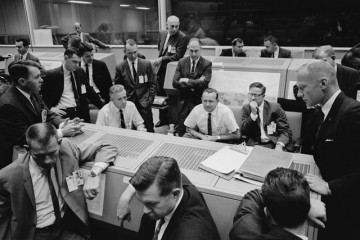
In spite of criticism that Houston’s selection had been politically motivated, with speculation that influence had been exercised by Vice President Lyndon B. Johnson and Chairman of the National Aeronautics and Space Council (NASC) Albert Thomas, the effort went ahead. The new center’s construction was implemented by the architect Charles Luckman—whose portfolio also included Madison Square Garden and the Los Angeles Convention Center—but it proved a difficult site to clear. “Less than a month after Webb’s announcement, a Houston journalist went on an inspection tour of the site planned for the spacecraft center,” noted Loyd Swenson, James Grimwood and Charles Alexander in This New Ocean: A History of Project Mercury. “He found cowboys driving herds of cattle to new pasture, a crew of surveyors from the Army Corps of Engineers mapping the prairie near Clear Lake and fighting snakes, and a lone wolf-hunter, with the carcass of a freshly slain wolf.” NASA Flight Director Chris Kraft, who would prove instrumental in the formation of the MCC at Houston, remarked in his memoir, Flight, that it was “hard to imagine that thie flat, low-lying piece of Gulf Coast scrubland was going to sprout engineering and test buildings, a new Mission Control Center and office space that would be the focal point of the human race’s first steps in off-planet exploration.”
The control center would feature a state-of-the-art Real-Time Computer Complex (RTCC) and a pair of separate, though identical, flight control rooms. Each consisted of a four-tiered auditorium, dominated by a large map-screen with Mercator projection of the globe, the locations of tracking stations and a three-orbit “sine-wave” track of the spacecraft. “We assumed that we’d be flying missions so closely together,” explained Kraft, “that one room would be dedicated to the current mission and the other to the upcoming mission. The computer complex had to support both rooms, so we had let that contract first.” In his mind, IBM was best qualified, having done an outstanding job on Project Mercury, and they were subsequently selected in October 1962. So too was Mercury veteran Philco Aerospace Company, which was chosen in March 1963 to build and equip the control rooms themselves. “With IBM and Philco,” reflected Kraft, “I figured that at least half of the worry had been lifted from my shoulders.”
Over the following years, Mission Control took shape and root in Building 30, a three-story, virtually windowless facility, into which Kraft and his team moved in the spring of 1964. Construction of the building was completed the following November, allowing sufficient time for equipment to be installed for a training simulation of the unpiloted Gemini 2 mission in January 1965.
During this period, it was steadily equipped with computers and flight control hardware, and in March Gemini 3 became the last mission to be directly controlled from Cape Canaveral. However, Flight Director John Hodge backed up Gemini 3 from Houston. Years later, Kraft remembered that the aging Mercury Control seemed “small and antiquated”, whereas Houston was “getting the same data we were, though on much more capable consoles and with a greater number of displays”. On 3 June, with the launch of Jim McDivitt and Ed White on Gemini IV, the primary Mission Control team was stationed in Houston, although a small staff was despatched to Mercury Control at the Cape in a backup capacity.
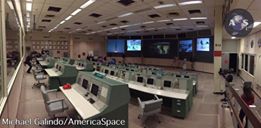
Training for Gemini IV, Kraft had been distinctly impressed by the new center’s systems and operation. “We’d been working in a small and even cramped control center during Mercury,” he wrote. “The Houston center was spacious, the computers were faster and had much more capacity, the modern intercom system worked and we were surrounded by support rooms where bright young systems people kept us supplied with every detail we requested.” In late May 1965, only days before McDivitt and White were due to launch, Kraft got into his car and the realization struck him: for the first time, he was not about to embark on the long drive to the Cape, to stay in a motel and eat in a chain of restaurants. Rather, he would be doing his job here, in Houston, and would be going home to his wife and children in Friendswood, for a home-cooked dinner. “For the first time, I fully understood that Mission Control wasn’t halfway across the country anymore,” he wrote. “It was in my own backyard and even during a mission I could sleep at home in my own bed.” However, there was one facet disliked by Kraft: the name, Mission Operations Control Room, or MOCR, pronounced moe-ker. “I never liked that name,” he reflected.
Over the coming years, MOCR-1, on the second floor of Building 30, would be utilized for the Apollo 7, Skylab and Apollo-Soyuz Test Project (ASTP) missions, whilst MOCR-2, on the third floor, was employed for Gemini IV through XI and for the Apollo lunar missions. Following the splashdown of Apollo 7 in October 1968, MOCR-1 was deactivated for more than two years of modifications, before it was brought back on-line in October 1971 to prepare for its Skylab/ASTP support role.
During the heady days of the late 1960s and early 1970s, the word “Houston” would crackle repeatedly over the airwaves between Earth-circling, Moon-bound and lunar-orbiting astronauts, as they advanced our civilization further than ever before into the cosmos. Apollo 8’s delivery into lunar orbit in December 1968 produced sheer pandemonium and the aroma of celebratory cigars scented the air of MOCR-2 for hours. “Houston, tell the world we have arrived!” exulted Apollo 10 Commander Tom Stafford, six months later, in May 1969, as they beheld their first view from lunar orbit, although it was events eight weeks later which cemented MOCR-2’s credentials and contributed to its eventual instatement as a U.S. National Historic Landmark and addition to the National Register of Historic Places.

On the evening of 20 July 1969, MOCR-2 was packed with virtually everyone involved in the U.S. space program, from Wernher von Braun and NASA Administrator Tom Paine to George Mueller, Sam Phillips, Chris Kraft, George Low, Deke Slayton, Flight Director Gene Kranz and many astronauts, including Charlie Duke, at the Capcom’s console. “Gene Kranz ordered the MOCR doors locked,” remembered Slayton in his autobiography, Deke, co-authored with Michael Cassutt. “Everybody who was in was staying in; if you were outside, tough. He delivered a little pep-talk to his crew, reminding them it was just like all the simulations. After the landing, they would go out and have a beer.” As described in another AmericaSpace article, the descent of Neil Armstrong and Buzz Aldrin toward the Sea of Tranquility, aboard the Lunar Module (LM) Eagle, was marred by program alarms, and for the first time the link between Mission Control and the astronauts briefly ended. “The partnership had all but dissolved,” wrote Andrew Chaikin in A Man on the Moon, noting that Armstrong, as the man in command, was now effectively running the mission.
Charlie Duke called to Kranz: “I think we’d better be quiet.”
“Rog,” acquiesced Kranz. “The only call-outs from now on will be fuel.”
As the astronauts neared the Moon, the silence in MOCR-2 was pervasive and enduring. Kranz crossed himself and prayed.
Shortly thereafter came the electrifying call which would forever enshrine “Houston” as a place synonymous with space exploration. “Houston, Tranquility Base here,” called Armstrong from the surface of another world. “The Eagle has landed!” The scene in those seconds was unbridled euphoria. “The whole MOCR was pandemonium,” wrote Slayton. “It took about 15 seconds to calm down at all!”
In the following five lunar landings, there were moments of humor and trauma. On Apollo 12 in November 1969, as he completed suiting-up for his first Moowalk, Commander Pete Conrad radioed “Houston, are we Go for EVA?” The response from MOCR-2 was not what he expected. “Stand by, Intrepid, we’ll be right with you,” said Capcom Ed Gibson, to which Conrad responded, with incredulity: “Stand by? You guys oughtta be spring-loaded!” Several months later, in April 1970, hearts leapt in throats when Apollo 13 Commander Jim Lovell called Earth with the harrowing “Houston, we’ve had a problem”, initiating a frantic effort to recover from an oxygen tank explosion and bring the crew home alive. And four days later, against so many odds, it was Capcom Joe Kerwin who repeatedly called “Odyssey, Houston, standing by”, as efforts to contact the returning Command Module (CM) were played out in front of a worldwide audience. When success was declared, and the spacecraft was spotted descending beneath its main parachutes, Kerwin reported “Odyssey, Houston, we show you on the mains. It really looks great!”
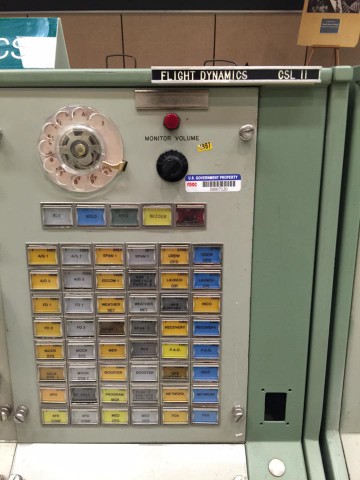
Houston would pass betwixt Earth and the Moon many times in the final lunar landings. “Ol’ Orion is finally here, Houston,” yelled Apollo 16’s Charlie Duke, upon the touchdown of LM Orion at the Descartes highland site in April 1972, whilst Apollo 17’s Gene Cernan could scarcely contain his own enthusiasm upon getting the Lunar Roving Vehicle (LRV) onto the surface from LM Challenger at Taurus-Littrow the following December. “Hallelujah, Houston,” he whooped. “Challenger’s baby is on the roll!” Five months after the Apollo 17 crew returned safely to Earth, MOCR-2 was deactivated and underwent a lengthy period of refurbishment, ahead of the Space Shuttle era. In 1976, IBM began installation of the Space Shuttle Data Processing Complex (SSPDC) to handle telemetry from the fleet of reusable orbiters and the following year MOCR-2 successfully supported the three Captive-Active Approach and Landing Tests (ALTs) of Enterprise, high above Edwards Air Force Base, Calif. Following these tests, all of the older equipment was removed from MOCR-2—which was renamed “Flight Control Room-2” (FCR-2)—and a process of integrating hardware for the operational shuttle program got underway. “The decision was made we’re no longer running missions,” explained Ground Control (GC) Officer Bill Foster in a NASA interview. “These were more flights, which is why we changed the name to FCR.”
The second-floor MOCR-1, meanwhile, had overseen all three Skylab missions in 1973-1974, as well as the U.S. segment of ASTP. This era was perhaps most significantly represented by Capcom Dick Truly’s call on the evening of 17 July 1975: “Moscow is Go for docking; Houston is Go for docking”, as American and Soviet piloted craft achieved a mechanized embrace in orbit for the first time. After ASTP, MOCR-1 was deactivated to begin preparations for the shuttle era and in March 1979—by now redesignated FCR-1—it staged the first fully-integrated simulation of STS-1, the first flight by orbiter Columbia. This was followed by pre-launch tests in November and full-duration mock missions in 1980, before FCR-1 took the leading role for the first four shuttle flights between April 1981 and July 1982.
In tandem, FCR-2 was brought online and took center-stage on STS-5, the first operational shuttle mission, in November 1982. Over the following 38 months, until the catastrophic loss of Challenger on the morning of 28 January 1986, FCR-1 supported a total of ten shuttle flights, whilst FCR-2 handled 15 flights, including Mission 51C, the program’s first dedicated Department of Defense assignment, and tragic Mission 51L itself. According to Ground Control (GC) Officer Bill Foster, the nature of the mainframe computers in the two FCRs—“It was a big job to reconfigure…all of the individual buttons were wired to outputs of the mainframe, so it took literally months to reconfigure from one shuttle mission to the next— In the wake of the Challenger accident, and the three-year standing-down of shuttle operations, both FCR-1 and FCR-2 were extensively upgraded, receiving new mainframe computers by September 1986 and improved workstations and local area networks by January 1989. The Mission Evaluation Room (MER) was moved from Building 45 to the third floor in readiness for a salvo of Department of Defense missions.
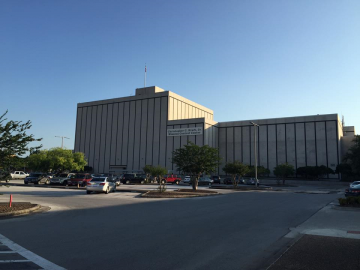
In September 1988, FCR-1 supported STS-26, the shuttle’s return to flight, whilst FCR-2 handled STS-27 in December of that same year. As the fleet returned to nominal operations, both control rooms received new front glass display screens and image projectors in December 1989 and FCR-2 was dedicated to six Department of Defense flights, including the final mission, STS-53, in December 1992. The latter was also FCR-2’s final usage as a flight control room. In view of its status as the nerve center for the Apollo 11 lunar landing, it had already been named a U.S. National Historic Landmark in October 1985 and was later added to the U.S. National Register of Historic Places. Following STS-53, FCR-2’s equipment was decommissioned and the room returned to its Apollo-era configuration.
Downstairs, on the second floor of Building 30, FCR-1 continued to provide complete support for all shuttle missions until STS-71 in June 1995 and partial support until the following year. A new FCR, known as the “White FCR”, had been commissioned in 1992 and following simulations in December 1994 was utilized to provide on-orbit support during Discovery’s STS-70 mission in July 1995. Following Discovery’s launch and deployment of its primary payload, the mission control team moved over to the White FCR for the remainder of orbital operations. The team then returned to FCR-1 for Discovery’s re-entry and landing. Over the next six shuttle missions, through March 1996, the two control rooms worked in tandem for launch, on-orbit and re-entry operations, before STS-77 in May 1996 became the first flight to be supported solely by the White FCR.
And that White FCR thus formed the backbone for the remainder of the shuttle era, handling each of the missions which followed—including Columbia’s final voyage—and the subsequent return to flight operations, through to the retirement of the fleet in July 2011. Concurrently, the Johnson Space Center (JSC) began extending Building 30 and a new, five-story section became operational in 1998, housing three FCRs—“White” for shuttle operations, “Blue” for International Space Station (ISS) activities and “Red” for training—whilst the original FCR-1 spent several years as an ISS Life Sciences Center, before being extensively remodeled for dedicated, 24-hour Space Station operations in October 2006. Speaking at the official reopening of FCR-1, Chris Kraft noted that he was sitting at a console in that very room on the day that astronauts Gus Grissom, Ed White and Roger Chaffee were killed in a flash fire which swept through the Command Module of their Apollo 1 spacecraft on 27 January 1967. “I’ve been frightened to death in here,” he explained, quoted in a NASASpaceflight.com article, “and I’ve seen people waving flags in here.”
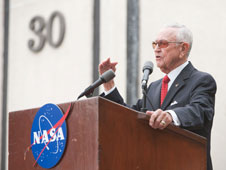
And Kraft’s legacy continues to this day. In April 2011, only weeks before the launch of the final mission of the shuttle era, the MCC was officially renamed the “Christopher C. Kraft, Jr. Mission Control Center”, in honor of the man whose guiding vision forged the facility which has shaped the United States’ fortunes in space over five decades. Speaking at the dedication ceremony, then-JSC Director Mike Coats said that “Houston” had been placed “on the intergalactic map forever” and added that “without Dr. Kraft’s leadership, the concept of Mission Control would not be what it is today”. Former flight director Glynn Lunney pointed out that “the control center today…is a reflection of Chris Kraft”.
Of course, Mission Control remains a living, breathing organism, constantly shifting as America’s human space program evolves. As NASA moves toward the Commercial Crew and Orion eras, the nerve center for controlling its human missions has continued to adjust. In 2012-2014, extensive upgrades were implemented as NASA prepares to implement a Mission Control Center for the 21st Century (MCC-21). Earlier today (Wednesday), AmericaSpace’s Michael Galindo was able to discuss MCC-21 with Mission Control Center Systems Facility Architect Dr. Shawn Gano, who has described the new architecture on his LinkedIn page as “the single largest modernization project in the history of the Mission Control Center”.
The Blue FCR, which was first to receive the MCC-21 upgrades, supported last December’s Exploration Flight Test (EFT)-1 of the Orion spacecraft. Dr. Gano told AmericaSpace that this opening mission followed a hybrid operating protocol, utilizing “old” software with “new” technology, pointing out that only the Orion spacecraft was the untried vehicle on EFT-1; all other components—United Launch Alliance’s (ULA) Delta IV Heavy, together with its upper stage—had proven track records. When Orion next flies, no sooner than November 2018, it will do so atop NASA’s mammoth Space Launch System (SLS), which Dr. Gano stressed will require MCC-21 hardware with far greater communications and data channels. He also explained that Beyond Low-Earth Orbit (BLEO) missions, beyond the Moon and perhaps as far afield as an asteroid, will require a larger communications pathway than the Tracking and Data Relay Satellite System (TDRSS) provides for low-Earth-orbiting missions. It will demand the resources of the Deep Space Network (DSN), unused for a piloted mission in almost five decades.
AmericaSpace questioned Dr. Gano as to his expectations for MCC over the coming decade, to which he responded that MCC-21 is “our big pinnacle upgrade” and that the systems are generally modernized every 20 years or so. For the foreseeable future, he anticipates that MCC advances will be “more evolutionary after this point, rather than revolutionary”.
As the Blue FCR presses into its next phase of operations, the White FCR was shut down after STS-135 and, in January 2013, commenced its own year-long phase of MCC-21 upgrades, ahead of its future role supporting Orion deep-space missions. Following the return to service of the White FCR, it would assume FCR-1’s 24-hour ISS Operations role, whilst the latter was decommissioned to undergo its own MCC-21 modifications.
This article would not have been possible without the on-site assistance, photography and insights of my AmericaSpace colleague Michael Galindo.
Want to keep up-to-date with all things space? Be sure to “Like” AmericaSpace on Facebook and follow us on Twitter: @AmericaSpace



